Current foreign programs for the development of advanced equipment for the "soldier of the future" (Future Soldier) are aimed at improving the combat capability of infantry with the help of technology, but set more realistic goals than some previous initiatives.
From Afghanistan to Ukraine, modern conflicts have proven that dismounted infantry remains a decisive military force. Although aviation, artillery and armored vehicles are irreplaceable, but in the end they only allow infantry to overcome the notorious "last 100 yards" of the battlefield. The role of personnel on foot is even more prominent in post-conflict operations, peacekeeping operations or counter-insurgency.
The Armed forces regularly upgrade infantry equipment in an effort to increase both its survival and lethality. The first decade of this century was marked – especially in the USA – by several extremely ambitious projects, the purpose of which was to use conceptual technologies to create "super soldiers" equipped with strength-enhancing exoskeletons and "Iron Man" suits, providing ballistic protection and integrating non-traditional weapons options. After many years of research, it became obvious that, at least for the moment, such concepts still belong to the realm of science fiction.
Soldier of the future for the French Armed Forces
Programs with more moderate parameters, such as the French Army's FELIN (Fantassin à Equipement et Liaisons Intégrés, or "Infantryman with integrated Equipment and Communications"), were implemented more readily. The industry team, led by Safran Electronics and Defense, delivered about 23 thousand FELIN kits to the French Armed Forces between 2010 and 2015. The system is used in airborne, mountain and motorized infantry units and, according to publications, has been successfully used in Afghanistan and Africa.
The modular system includes improved communication equipment and sensors, infantry weapons and advanced aiming tools, ballistic protection and ergonomically optimized uniforms and seat belts. The kit can be configured according to the mission parameters and the role of an individual soldier in a unit or echelon.
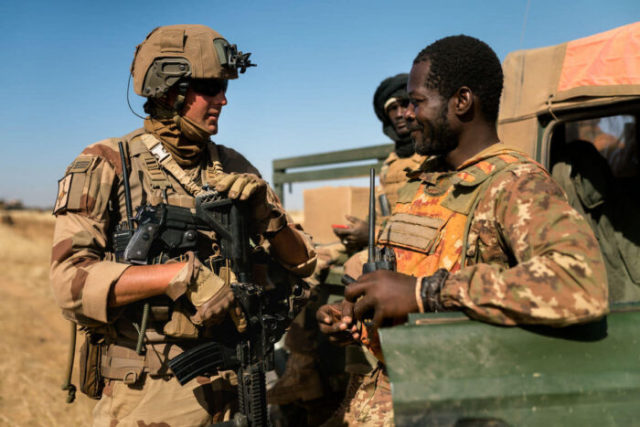
The new ballistic helmet of the French Armed Forces F3
Immediately after the purchase of the original FELIN kits was completed, the General Directorate of Armaments (DGA) signed a contract with Safran in 2016 to upgrade the system to the FELIN V1 standard.3. Improvements include software updates for targeting and fire support sensors, more modular protective gear, and improved combat vests optimized for the tactical SitComdé terminal and combat control systems. The third version also provided for reducing the weight of the system by 40% without compromising the level of protection.
Later, in 2019, the DGA launched the Centurion initiative. The program runs until 2026 and aims to accelerate the innovation of French industry and the integration of new technologies into existing programs, including future FELIN increments. The goal is to improve the "individual and collective capabilities of the fighter" with the help of technologies such as connectivity and communication, positioning and navigation, innovative interfaces, protective and unobtrusive equipment, vehicles, surveillance and identification means, innovative energy sources, monitoring of soldiers' health and functional textiles.
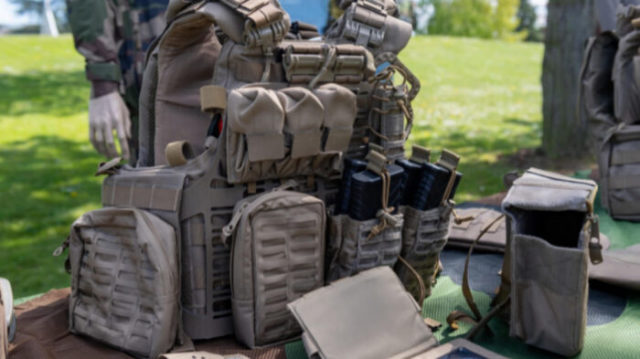
Modular ballistic design of the new generation SMB of the French Armed Forces
In 2017, the French Navy introduced a new generation modular ballistic design (SMB), or "modular ballistic design". SMB is an alloy of a ballistic protection bulletproof vest and a combat equipment transportation system. It is claimed that the design increases mobility and comfort due to lower weight and improved ergonomics compared to its predecessors.
Current programs for soldiers of the future in other countries follow the same approach, consisting in the systematic introduction of gradually improved equipment and new materials and using them in the form of holistically balanced packages to improve the combat capabilities of soldiers. Wearable electronics and advanced networking capabilities are considered vital elements of all these programs. Two typical approaches are the US Army and the German Army ru/voennoe-stroitelstvo-gosudarstv/silovie-strukturi-gosudarstv/suhoputnye-vojska-germanii/." target="_blank" rel="nofollow">.
U.S. Army Infantry
The current efforts of the US Army to modernize the infantry are focused on several disparate, parallel, but independent projects to develop new infantry weapons, wearable sensors and situational awareness tools, as well as personal protective equipment (PPE). The Next Generation Squad Weapons Program (NGSW), Integrated Vision Enhancement System (IVAS ) and advanced night vision glasses – binoculars (ENVG-B) are among the highest priority or "branded" developments of the army. Their development is led by the cross-functional group to combat soldier lethality of the Command of the Future (Army Futures Command).
Squad weapons of the next generation
The NGSW system consists of four elements. The XM7 rifle (according to other sources, the XN5) will replace the M4 carbine. The XM250 automatic rifle with belt power will replace the M249 light machine gun. Both types of gas-powered weapons are being developed by Sig-Sauer under a 2022 contract . They are planned to be equipped with an additional combined sound muffler and muzzle brake developed by army engineers. Army tests show that the silencer reduces recoil by 33%, flash range by 25% and acoustic visibility by 50%.
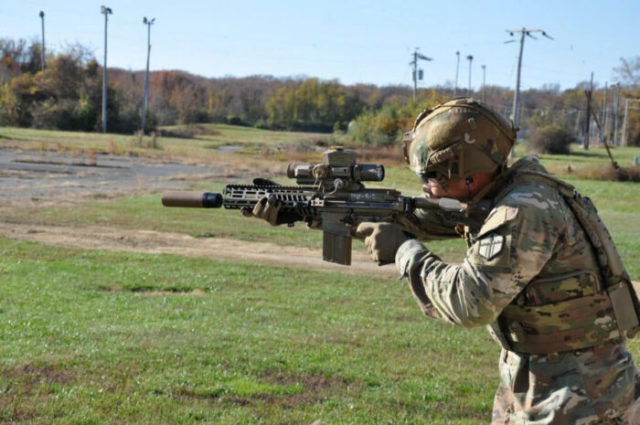
Sig Sauer XM7 Rifle
NGSW-Fire Control (NGSW-FC) is an integrated optical system designed to provide improved target detection and aiming correction for both types of weapons. The development contract was signed with Vortex Optics in 2022. The main components of FC include a variable-power optical sight, a laser rangefinder, a ballistic computer, an aiming grid with distortions (meaning two aiming points observed when looking through the sight, with one aiming point aligned with the aiming line, and the second tracking the target with an electronic "tag") and wireless communication with soldiers devices. It autonomously calculates range, wind and altitude and adjusts the aiming point accordingly, while simultaneously displaying the target location, distance and status on the soldier's display.
The last component of NGSW is the new 6.8×51 mm cartridge (.277 Fury), designed taking into account the greater weight of the bullet and its muzzle velocity compared to 5.56×45 mm M4 ammunition. In general, it is expected that NGSW will significantly increase the range, accuracy and defeatability of the target compared to modern infantry weapons. The stated goal of the army is "to achieve superiority over global opponents and threats that arise on the battlefield today and tomorrow."
The system has recently completed qualification tests for production, and it is planned that the first operating unit will be equipped with NGSW in the second quarter of fiscal year 2024. Within 10 years, the US Army plans to purchase 250 thousand XM7 and 150 thousand XM250 .
Integrated vision enhancement system
IVAS is a derivative of the Microsoft Hololens 2 headset, which uses holographic technology to overlay digital images on real-world images. According to Microsoft, thanks to the combination of HoloLens mixed reality technologies with thermal imaging, sensors, GPS technology and night vision capabilities, the system is designed to improve situational awareness of soldiers and transmit tactically significant information.
Holographic images, three-dimensional terrain maps and a compass are superimposed on the head-up display (HUD). This includes intelligence and targeting data from the unit's unmanned aerial vehicles (UAVs). The main components are a visor mounted in a helmet, a computer (called a "puck") that is worn on the body, a network radio station for data transmission and three conformal batteries. A wireless interface connects the glasses to a family of weapon sights, projecting the weapon's reticle and thermal image of the target onto the glasses' display, which allows military personnel to stay in cover while simultaneously pulling weapons – even from around the corner - to aim and fire at the enemy.
A soldier tests an IVAS headset during an exercise at Fort Bragg, North Carolina
The initial tests of the IVAS 1.0 demonstrators took place in the military in 2022. The demonstrators were soon followed by improved IVAS 1.1 prototypes. The feedback received revealed numerous problems: disorientation and neck strain, which are scheduled to be eliminated in iteration 1.2. The first IVAS 1.2 prototypes were transferred to the troops in July 2023, and the equipment is expected to be commissioned in 2025.
ENVG-B
Created by L3Harris, the ENVG-B night vision binoculars mounted on the helmet enhances the image due to white phosphor and long-wave infrared radiation (LWIR), which allows you to improve the overview of the battlefield in low light conditions and deteriorating weather conditions.
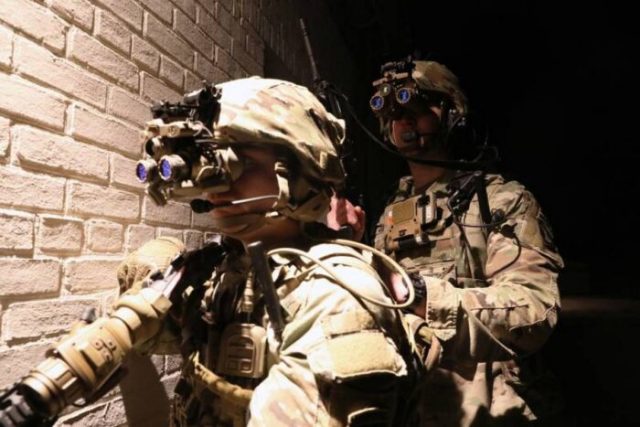
ENVG-B on exercises, February 2021
Thanks to integration with the NETT Warrior system (described below), the glasses can also display maps, navigation and tracking of their (friendly) forces. Like IVAS, ENVG-B is designed to increase mobility, survivability and lethality in difficult conditions by significantly expanding situational awareness and improving the ability of soldiers to identify targets and hit them. The army plans to purchase 40 thousand sets by 2028.
NETT Warrior System
NETT Warrior (NW) is an integrated situational awareness system for dismounted infantry commanders (Squad Commander level and above). The cross-platform system uses a portable military radio station as an interface to connect a ready-made commercial smartphone (COTS) to the command and control network at the brigade level.
Through a smartphone, a soldier gets access to applications for tracking friendly forces, coordinating movements with other units, requesting fire support, sending messages and exchanging data. The system can also be connected to sensors of small unmanned ground vehicles (UGVs) and UAVs.
Along with user applications, NW uses the Tactical Assault Kit (TAK) situational awareness software package based on maps. The system was introduced in 2010. To date, it has undergone several modifications, both to improve performance and to reduce weight. Currently, the third option is being tested and can be delivered to separate units in 2024. The main goal of the latest development is an improved artificial intelligence to optimize the interface with other new equipment of the soldier of the future.
The system of protection of American soldiers of the future (SPS[/b])
The SPS (Soldier Protection System) protection system went into production (depending on the component) in the period from 2016 to 2019 and consists of:
- Torso and Limb Protection (TEP), which includes a modular scalable vest (MSV), a lightly armored, fire-resistant combat shirt (Ballistic Combat Shirt) and shockproof pelvic protection to reduce the risk of groin injury;
- a set of vital trunk protection (VTP) of front, rear and side armor plates for installation in MSV;
- integrated Head protection System (IHPS), consisting of a basic helmet, which can be supplemented with armor for the lower jaw and protective glasses.
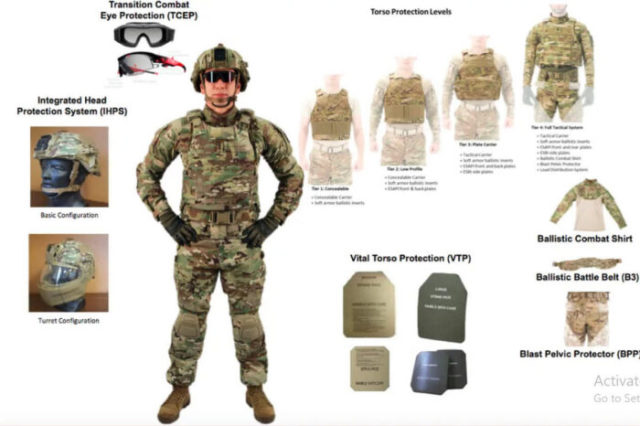
SPS protection system
The SPS is designed to provide an equal or greater degree of protection than outdated body armor from small arms fire and shrapnel, but at a lower weight. Individual components of the modular system can be configured for different levels of protection according to mission parameters and personnel needs.
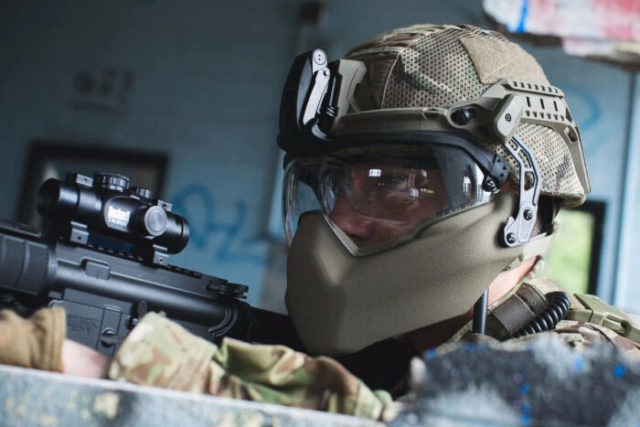
Integrated IHPS head protection
Currently, three SPS elements are being upgraded. The new components are the second generation Modular Scalable vest (MSV Gen II), the third generation Vital Trunk Protection (VTP Gen III) and the next generation Integrated Head Protection System (NG-IHPS). The MSV Gen II and VTP Gen III began entering service in 2021. Ballistic tests are continuing, and the failure rate remains below 5% so far. The army plans to purchase 150 thousand sets of each component.
Soldiers of the future Bundeswehr
German programru/obraszi-vooruzhenija-i-voennoj-tehniki/novie-voennie-tehnologii/pehotinets-budushhego-snaryazhenie-soldata-bundesvera/ " target="_blank" rel="nofollow">"Infantryman of the Future" (Infanterist der Zukunft, IdZ) was launched in 2004 as an urgent operational need to equip the contingent deployed in Afghanistan. To accelerate the implementation, the initial phase of IdZ-BS (basic system) was based on components that were present on the market (COTS).
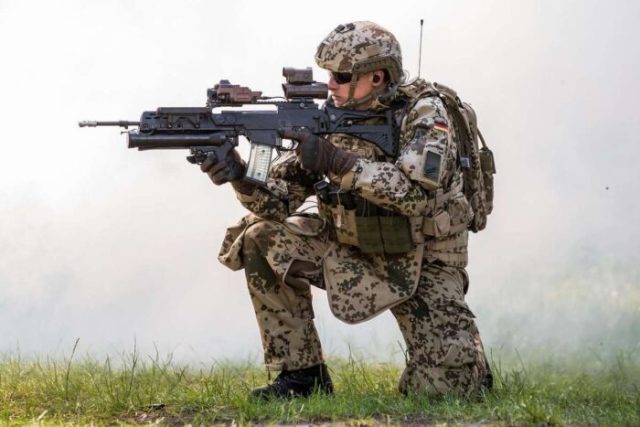
German soldier with a set of "Infantryman of the future"
Currently, the presented iteration has received the designation IdZ-ES (Erweitertes System, or "extended system") Gladius. The development has been carried out since 2006 by the general contractor Rheinmetall Defense Electronics, deliveries began in 2013. The 'ES' kit was conceived "from scratch" because, as the German army stated, "the basic capabilities needed by an infantryman can only be realized with the help of a closed and coordinated systematic approach." In addition to increasing productivity, the new equipment is also ergonomically optimized and has a reduced weight, which has contributed to improving the mobility of soldiers and reducing their fatigue and risk of injury.
Currently, the German Armed Forces have approximately 165 platoon sets, which are enough to equip 6,600 military personnel (mainly ground forces, although other services have also been provided with a limited number of sets).
IdZ consists of three subsystems: "Clothing, protective and load-bearing equipment" (BST, Bekleidung, Schutz- und Trageausstattung), "Weapons, Optics and Optronics" (WOO) and "Command, Control, Computers, Communications and Information" (C4I). The whole system is modular, which allows you to connect elements of each subsystem to meet the needs of light or mechanized infantry or reflect the functions of an individual soldier in a unit.
The common core consists of communication and network equipment built into the vest, including a USB hub (to which electronic communications, data transmission and sensor devices are connected), tactical radios, a visual display, digital navigation devices, several conformal batteries and a communication headset.
The core is complemented by a selection of almost 80 options distributed across various categories, including helmet-mounted and weapon-mounted viewing modules and fire control units, multi-mode binoculars, augmented reality devices, numerous samples of customizable firearms and grenade launchers, as well as personal protective equipment (PPE).
The IdZ family continues to be updated regularly and, according to Western experts, is considered one of the most advanced infantry systems in the world. As for the BST and WOO subsystems, recent improvements have mainly been aimed at reducing weight and improving usability.
The characteristics of individual sensors and sights are gradually improving, and now the greatest efforts are being made to C4I systems, since they are the key to combining all the elements into a force multiplication package. Deliveries of the newest version of IdZ, designated as "IdZ-ES VJTF 2023", began in 2021, and additional orders were placed in January 2023. This option is optimized for the German contingent heading the NATO High Readiness Joint Task Force (VJTF) in 2023.
New aspects include upgraded software-defined radios, as well as improved situational awareness and target detection functions. These include the CeoTronics CT-MultiPTT 3C central operating unit on the chest, which displays the location of the blue forces on the tactical map. IdZ-ES VJTF 2023 is compatible with the new German Armed Forces Ground Operations Digitization Program (D-LBO), which is designed to provide the basis for mobile command and control (C2) networks.
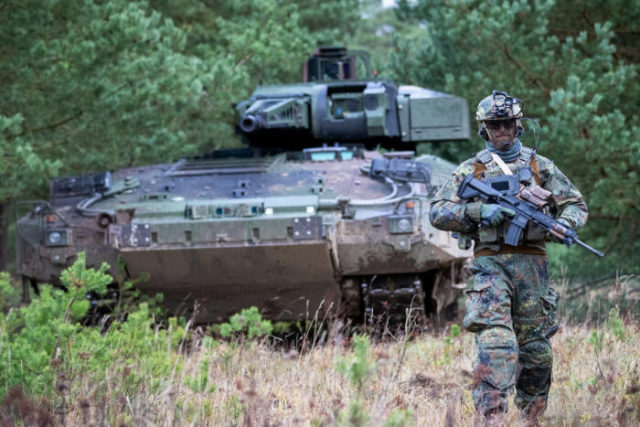
The "Motorized Infantry" system
Together with the upgraded electronics and communication equipment on the Puma BMP and other classes of IdZ-ES armored fighting vehicles, the VJTF 2023 also forms the basis for the Panzergrenadier system, which will be deployed together with the NATO VJTF for the first time. The Panzergrenadier system completely combines sensors of vehicles and weapons with sensors of amphibious assault vehicles and dismounted infantry, creating a single operating environment. This combination of dismounted infantry and infantry fighting vehicles into a real combat unit allows you to detect enemy forces, identify them and effectively hit them at a greater distance and with increased accuracy. Thus, the Bundeswehr forms a new basis for the integration of dismounted infantry with its infantry fighting vehicles.
In 2021en/voennoe-stroitelstvo-gosudarstv/silovie-strukturi-gosudarstv/suhoputnye-vojska-germanii/" target="_blank" rel="nofollow">The German Army commissioned Rheinmetall to begin research on the next generation soldier of the future system, which will receive the designation IdZ 3.0. It is assumed that it will be based on the digital basis of existing options and include new equipment. Full details have not yet been determined, although several new components are known. In particular, the new assault rifles G95A1 and G95KA1 (more commonly known as HK416 A8), which from 2024 will begin to replace the current G36. New sensors and sights for weapons are also expected.
One of these components will be the FCS 12 fire control system, which combines several functions, including a day or night sight, a laser rangefinder, a ballistic computer and video recording equipment. As Jan GESAU, the first director of the Federal Armament, Information Technology and the Use of the Bundeswehr (BAAINBw), stated in an interview, the results of relevant research "will be constantly taken into account when developing the next steps to implement the third generation" of the IdZ system.
Ultimately, experts believe, as soon as a certain set of equipment enters service, the military should begin planning its modernization in order to keep up with technology and with potential adversaries.
According to the materials of the resource euro-sd.com

